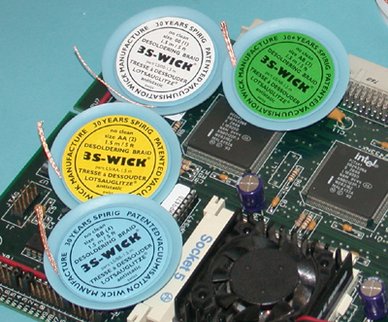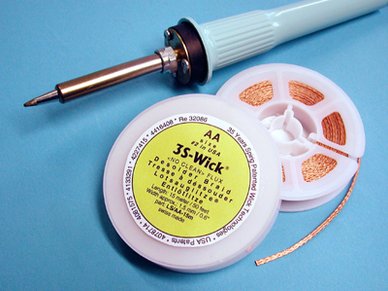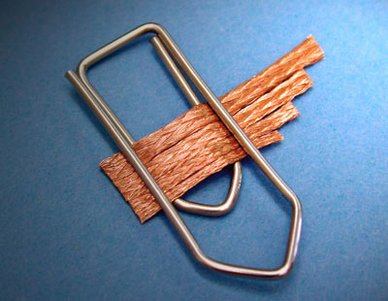
3S-Wick® Solder Removal Wick
3S-Wick® patented vacuumization technology is preferred by leading organizations worldwide. Vacuumization yields a high-speed response wick for quickest and safest de-soldering. A simultaneaous comparison dip-test (MIL-STD-202 E Method 208 C) with competitive wicks will show the differences.
3S-Wick® flux is based on mildest non-corrosive, non-hygroscopic, non-conductive rosins of 'no-clean' quality.

3S-Wick® conforms to the most stringent soldering standards set worldwide i.e. DIN-8516, DIN-8527, DIN-8511-F-SW32 (German), BS-441, DTD-599A (British), JIS-C-2519, JIS-C-2512 (Japanese), ASTM-B284, NASA Publications MIL-F-14256D type W and A, NPC-200-4 Quality Publication, NASA-SP5002 Soldering Electrical Connections, NASA-NHB-5300 Reliability and Quality Assurance Publications, and others.
3S-Wick® is used and has been used for the most demanding desoldering operations in spacecraft and military electronics. 'No-clean' residues can be left safely on the desoldered area.

IMPORTANT
The minimal residues left on the soldered area do also act as a solderability conservation for that area, should the resoldering not be done immediately there.
The technical term 'no-clean' Wick found in desolder braid descriptions and specs usually refers to a wick whose desoldering operation only leaves a minor amount of flux on the desoldered area and which do use a flux composition whose residues can be left safely on the desoldered area.
A fluxless wick as often proposed does not exist and can not function by metallurgical reasons.
LOTSAUGLITZE® is a German word created about 50 years ago by Spirig and is registered as a trademark for Spirig. The commercial wicking technology to remove solder was established in Europe by Spirig.
Entlötlitze is also a recently created German word expression for desoldering braid and the use of Entlötlitze is free for the public use to describe this desoldering technology/products.
Sizes
| Size | Identification colour | Width approx. | Spool lengths | Application | Recommended minimum iron wattage * |
| '00 | white |
0.03in 0.80mm |
1.5m 15m 25m | very fine solder joints | starting at 20 Watt |
| AA | yellow |
0.06in 1.5mm |
1.5m 15m 25m | fine solder joints | starting at 30 Watt |
| AB | green |
0.08in 2.2mm |
1.5m 15m 20m | medium solder joints | starting at 50 Watt |
| BB | blue |
0.10in 2.7mm |
1.5m 15m | large solder joints | starting at 80 Watt |
TIPPS AND TRICKS
TIP #1
Use of solder tips with a chisel like tip end. Allows to softly and evenly squeeze the wick structure across the desolder area. Heat transfer is optimal.
TIP #2
As a chisel sized tip preferably use one with approximately width of wick size.
TIP #3
Having a too wide wick for a small pad? -> Cut the wick in an angle. This makes a fine wick end with lower thermal mass.
TIP #4
Having a too small wick or a too big solder deposit area? Fold the wick end and you get the needed "larger" sized wick. Make sure tip has enough thermal mass to heat the enlarged wick mass properly.
TIP #5
Desoldering is soldering the wick end with the solder to be removed. Using the well known solderability dip test allows to check and compare any wick for proper desolder function and speed of absorption.
TIP #6
3S-Wick® / Desolder braid does recommend the use of electronic or thermostat temperature controlled soldering irons.
3S-Wick® Desolder braids
(Types 00, AA, AB and BB in different sizes and lengths)
comply with
EC Directives 2002/95/EC (RoHS1)
EC Directives 2011/65/EC (RoHS2)
EC Directives 2015/863/EC (RoHS3)
EC Regulation (EC) No 1907/2006 of the European Parliament (REACH)
SVHC 211
EC Regulation (EC) No. 1272/2008 of the European Parliament (CLP)
Directives 2012/19/EU (WEEE)
CFSI Conflict-Free Sourcing Initiative
